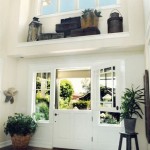Hanging Money Plant Decoration Ideas: A Guide to Greenery and Prosperity
The money plant, scientifically known as *Epipremnum aureum*, is a popular houseplant renowned for its ease of care and purported ability to bring prosperity. Its cascading vines and vibrant green foliage make it an excellent choice for hanging displays, adding a touch of natural beauty to any indoor space. Incorporating hanging money plants into home decor is a versatile way to enhance aesthetics, purify air, and introduce a touch of nature into urban living environments. This article explores various decorative applications of hanging money plants, offering practical ideas for integrating them into different interior design styles.
The money plant's adaptability allows it to thrive in a range of conditions, although it prefers bright, indirect light. Direct sunlight can scorch its leaves. It's also tolerant of infrequent watering, making it a suitable choice for individuals with busy schedules. The plant can be grown in soil or water, further expanding its decorative potential. Whether suspended from macrame hangers, cascading from shelves, or trained along walls, the money plant offers a dynamic and visually appealing element to indoor spaces.
Utilizing Macrame Plant Hangers
Macrame plant hangers provide a bohemian and artisanal touch to any room. Their intricate knotwork adds texture and visual interest, complementing the trailing vines of the money plant beautifully. The variety of macrame designs available allows for customization based on personal preference and interior design theme. From simple, minimalist designs to elaborate, multi-tiered creations, macrame hangers can accommodate different pot sizes and styles, offering a flexible approach to displaying hanging money plants.
When selecting a macrame hanger for a money plant, consider the weight of the pot and the length of the vines. A sturdy hanger made from durable materials like cotton or jute is essential to support the plant's weight without sagging or breaking. The length of the hanger should also be appropriate for the height of the ceiling and the desired visual effect. Longer hangers create a dramatic cascading effect, while shorter hangers provide a more compact and subtle display. Furthermore, the color of the macrame hanger can be chosen to complement the surrounding décor, adding a cohesive element to the overall design.
Placement is key when using macrame hangers. Ideally, the hanger should be positioned near a window that receives bright, indirect light. Avoid placing the plant directly in front of a window that receives intense afternoon sun, as this can damage the leaves. Consider the surrounding furniture and wall color when choosing the location. A macrame hanger with a money plant can serve as a focal point in a room, drawing the eye and adding a sense of natural tranquility. Alternatively, it can be used to soften the lines of hard furniture or to add visual interest to a blank wall.
Cascading from Shelves and Ledges
Allowing a money plant to cascade from shelves and ledges creates a natural and organic feel in a room. This method of display accentuates the plant's trailing growth habit, creating a visually stunning effect as the vines spill over the edges. Shelves offer a stable and secure base for the plant, while ledges provide a more minimalist and unobtrusive option. The choice between shelves and ledges depends on the available space, the desired aesthetic, and the overall design of the room.
When using shelves, consider the material and style of the shelving unit. Wooden shelves provide a warm and rustic aesthetic, while metal shelves offer a more modern and industrial feel. The size of the shelf should be appropriate for the size of the pot and the anticipated growth of the money plant. Ensure that the shelf is strong enough to support the weight of the plant, especially as it matures and the vines become longer and heavier. Placing multiple money plants on different shelves at varying heights can create a layered and dynamic display.
Ledges, on the other hand, offer a more streamlined and subtle approach to displaying cascading money plants. A narrow ledge can be installed along a wall, providing a discreet platform for the plant to grow. This method is particularly well-suited for small apartments or spaces where floor space is limited. The simplicity of a ledge allows the natural beauty of the money plant to take center stage, creating a visually appealing focal point without overwhelming the surrounding décor. When using ledges, ensure that they are securely mounted to the wall to prevent the plant from falling.
Regardless of whether shelves or ledges are used, proper watering and maintenance are crucial for the health and appearance of the money plant. Provide adequate drainage to prevent waterlogging, and trim the vines as needed to maintain the desired length and shape. Regular pruning encourages fuller growth and prevents the plant from becoming too leggy. Dust the leaves regularly to keep them clean and healthy, allowing them to absorb sunlight effectively.
Training the Plant Along Walls and Structures
Training a money plant to grow along walls or other structures offers a unique and creative way to incorporate greenery into interior design. This method involves gently guiding the plant's vines along a predetermined path, using clips, ties, or adhesive products to secure them in place. The result is a living wall of foliage that adds a touch of natural elegance to any room. This approach requires patience and attention to detail, but the visual impact can be truly remarkable.
Several methods can be used to train a money plant along walls. One common approach is to use small, transparent clips that attach to the wall with adhesive. These clips are discreet and do not detract from the plant's appearance. They allow the vines to be easily repositioned as the plant grows. Another option is to use plant ties, which are small, flexible wires covered in plastic. These ties can be wrapped around the vines and then attached to a nail or hook in the wall. This method provides a more secure and adjustable hold.
When training a money plant, it is important to choose a wall that receives adequate indirect light. Avoid walls that are exposed to direct sunlight, as this can burn the leaves. Also, consider the wall's surface. Avoid using adhesive products on delicate surfaces like wallpaper, as they may damage the material. Painted walls are generally suitable for most adhesive products, but it is always a good idea to test a small area first to ensure that the paint does not peel. Furthermore, ensure the chosen method of attachment does not damage the plant's stem.
The money plant can also be trained to grow along trellises, arches, or other decorative structures. This approach allows for greater creativity and flexibility in design. A trellis can be placed against a wall, providing a framework for the plant to climb. Alternatively, an arch can be used to create a dramatic entrance or focal point. These structures can be made from a variety of materials, including wood, metal, or plastic. The choice of material depends on the desired aesthetic and the overall design of the room.
Integrating Hanging Money Plants into Different Interior Styles
The versatility of the money plant allows it to be seamlessly integrated into a wide range of interior design styles, from minimalist and modern to bohemian and rustic. By carefully considering the plant's placement, the choice of pot, and the surrounding décor, it is possible to create a cohesive and visually appealing space that reflects personal taste and style preferences.
In minimalist and modern interiors, hanging money plants can be used to add a touch of organic warmth and texture to otherwise sterile and uncluttered spaces. Simple, geometric pots in neutral colors like white, gray, or black complement the clean lines and understated aesthetic of these styles. The plant can be suspended from a single hook or placed on a minimalist shelf, allowing its natural beauty to stand out without overwhelming the space.
Bohemian and eclectic interiors, on the other hand, embrace a more free-spirited and maximalist approach. Hanging money plants can be incorporated into macrame hangers with intricate knotwork or placed in colorful, patterned pots. Multiple plants can be grouped together at varying heights to create a lush and vibrant display. This style also lends itself well to training the plant along walls and structures, creating a living tapestry of foliage.
Rustic and farmhouse interiors benefit from the natural and earthy qualities of the money plant. Terracotta pots, wooden shelves, and jute hangers complement the warm and inviting atmosphere of these styles. The plant can be used to soften the hard lines of wooden furniture or to add a touch of greenery to a kitchen window. The cascading vines of the money plant create a sense of natural abundance and tranquility, enhancing the overall feeling of comfort and relaxation.
Maintaining the Health and Vigor of Hanging Money Plants
Maintaining the health and vigor of hanging money plants is essential for ensuring their longevity and aesthetic appeal. Proper watering, fertilization, pruning, and pest control are crucial aspects of plant care. By providing the right conditions and attention, it is possible to keep hanging money plants thriving and looking their best for years to come.
Watering is a key factor in the health of a money plant. The plant prefers to be kept slightly moist, but not waterlogged. Overwatering can lead to root rot, which can be fatal. Allow the soil to dry out slightly between waterings, and then water thoroughly until excess water drains out of the pot. The frequency of watering will depend on the climate, the humidity, and the size of the pot. During the winter months, when the plant is not actively growing, watering can be reduced.
Fertilization provides the plant with the nutrients it needs to grow and thrive. Use a balanced liquid fertilizer diluted to half strength every month during the growing season (spring and summer). Avoid fertilizing during the winter months, when the plant is dormant. Over-fertilizing can damage the roots, so it is important to follow the instructions on the fertilizer label carefully.
Pruning helps to maintain the shape and size of the plant, as well as to encourage fuller growth. Trim the vines as needed to prevent them from becoming too long or leggy. Pinch off the tips of the vines to encourage branching. Remove any yellow or brown leaves, as these are a sign of stress or disease. Pruning can be done at any time of year, but it is best to do it during the growing season, when the plant is actively growing.
Pest control is an important aspect of plant care. Money plants can be susceptible to pests such as spider mites, mealybugs, and aphids. Inspect the plant regularly for signs of infestation. If pests are detected, treat the plant with an insecticidal soap or neem oil. These products are effective at controlling pests without harming the plant. Avoid using harsh chemicals, as they can damage the leaves.

Money Plants Decoration Ideas Indoor Growing Green Plant Decor N

Money Plant Wall Hanging Ideas For Home Room Garden Gardening Indoor Plants

5 Money Plants Hanging Decoration Ideas For Any Space

Money Plant Decoration

Money Plant Decoration Ideas For Artificial Real Plants

Your Guide To Growing A Money Plant At Home

Money Plant Decoration Ideas Growing Hanging Plants

Money Plant Wall Hanging Decoration Ideas Plants Indoor Green Decor In 2025

Recycle Plastic Bottle Into Money Plant Decoration Ideas That Purify The Indoor Air Green Decor

5 Hanging Plants To Spruce Up Your Home Decor
Related Posts







